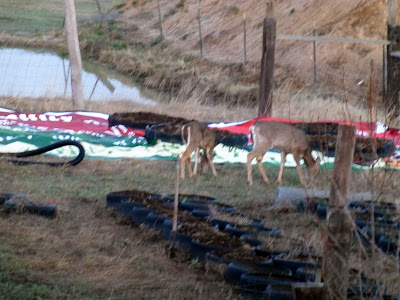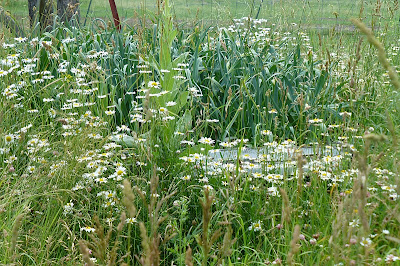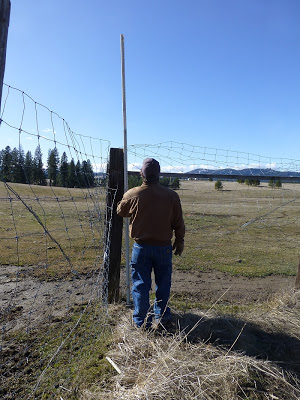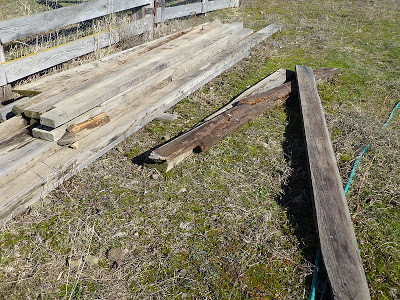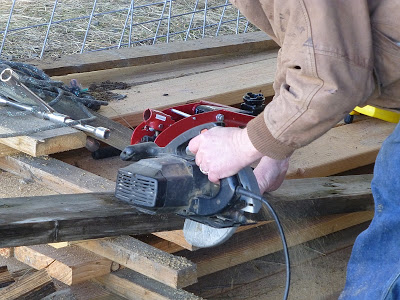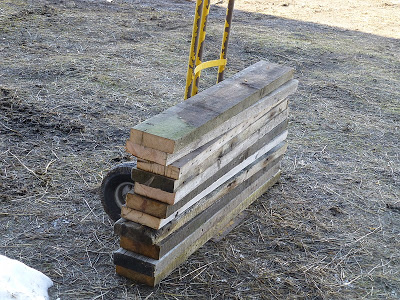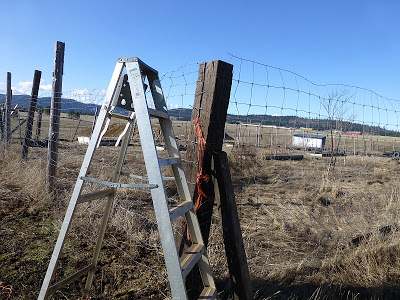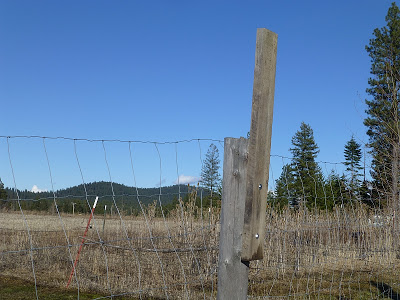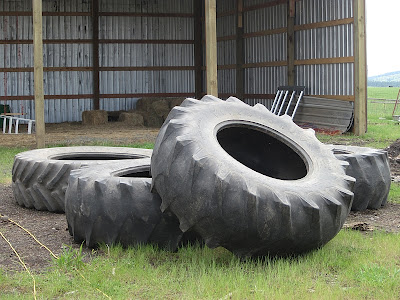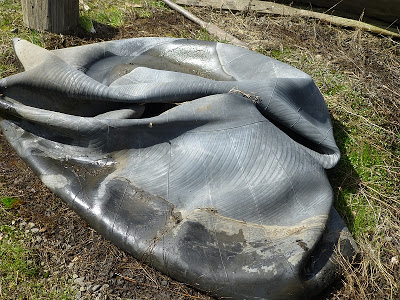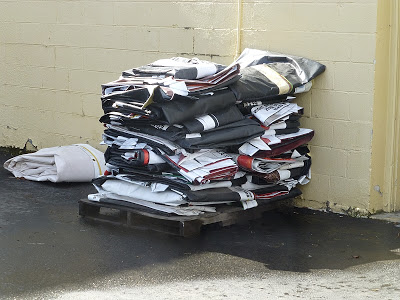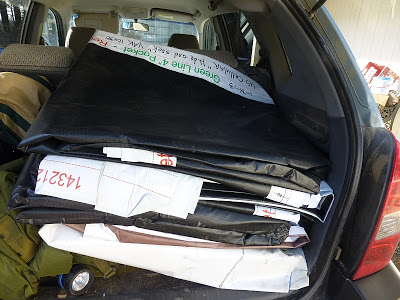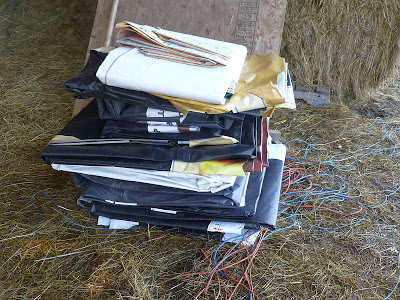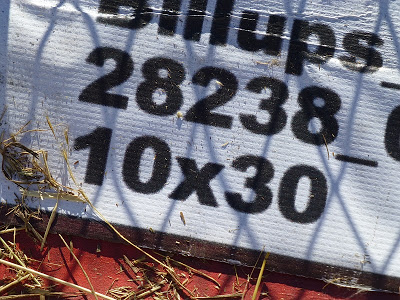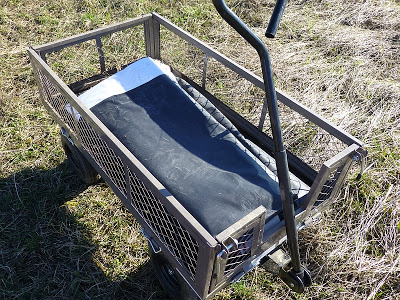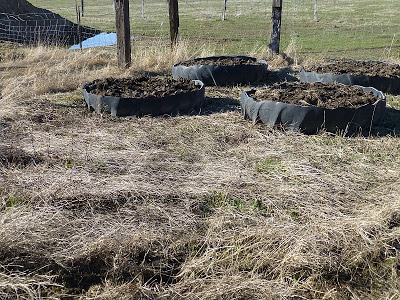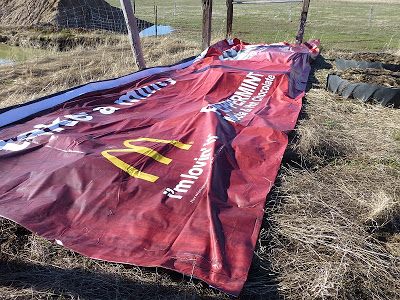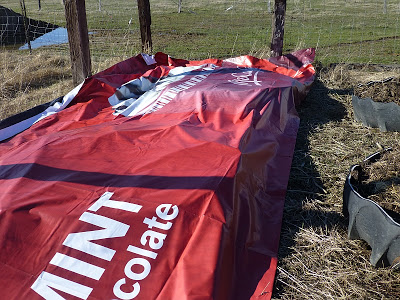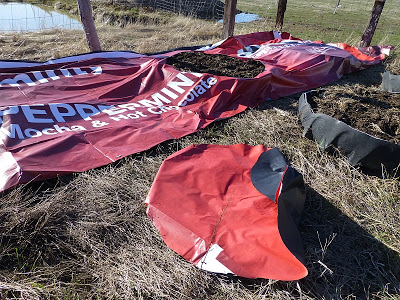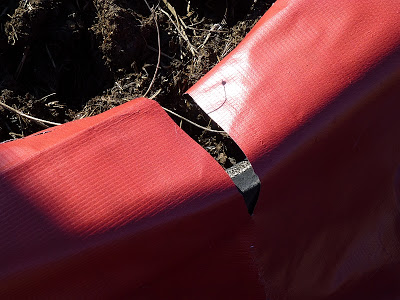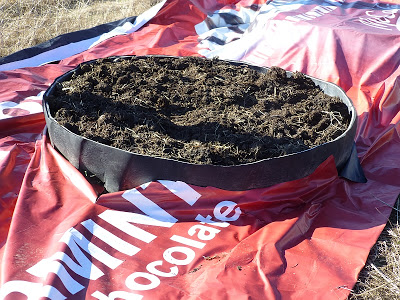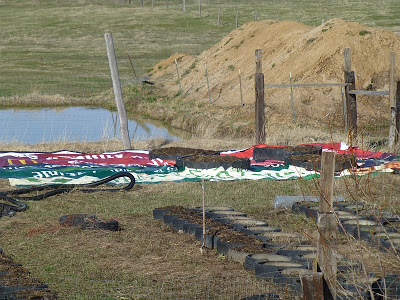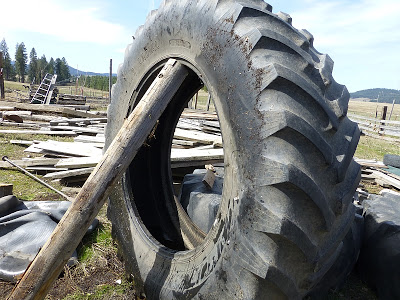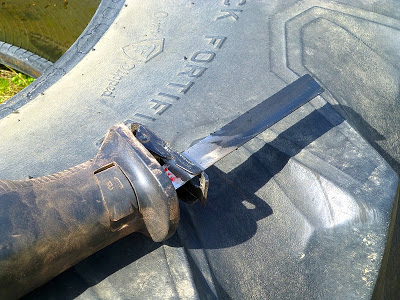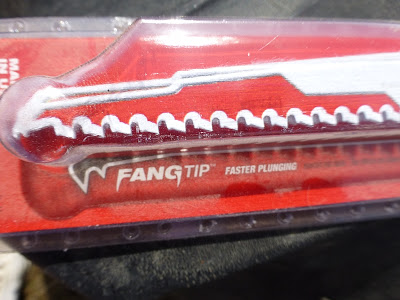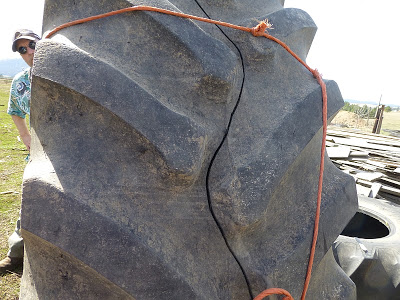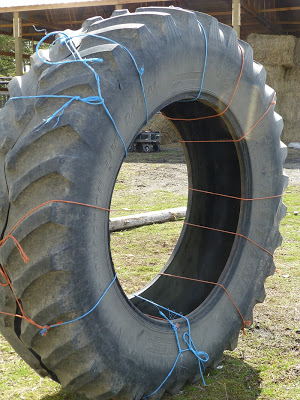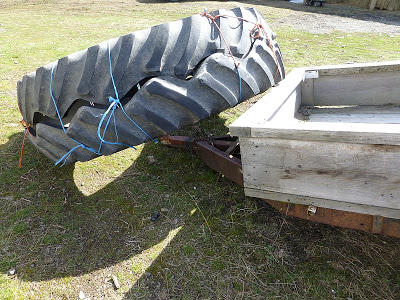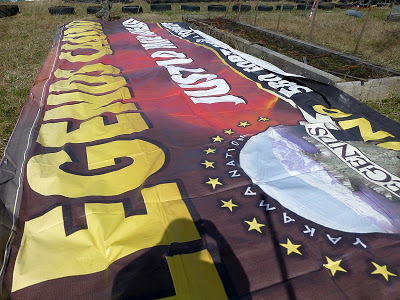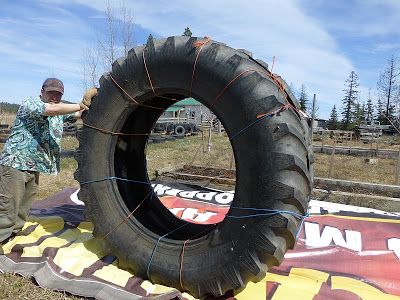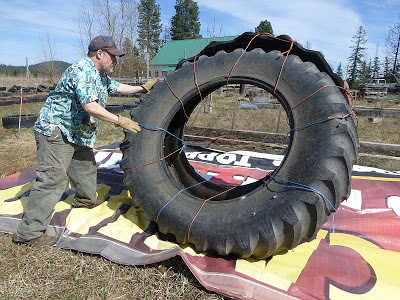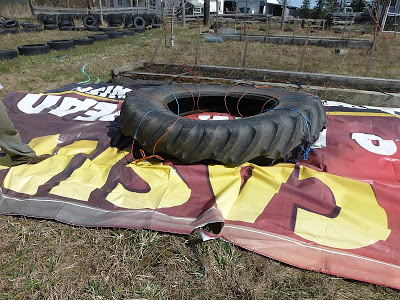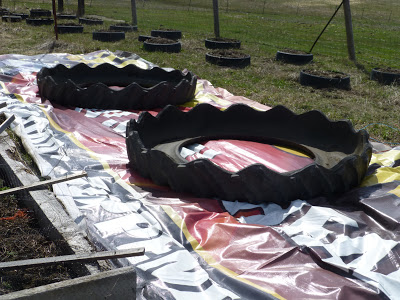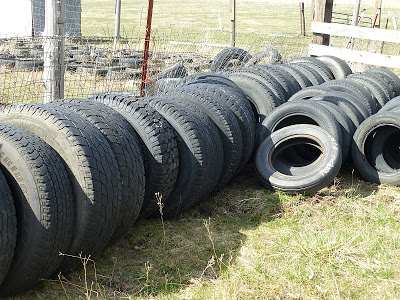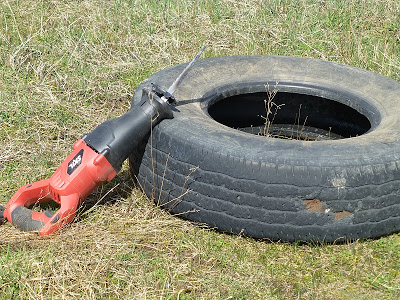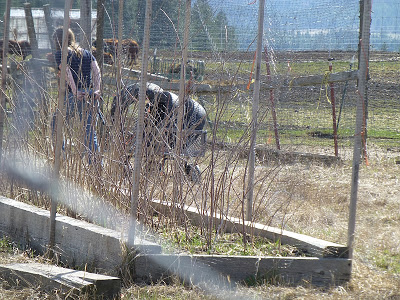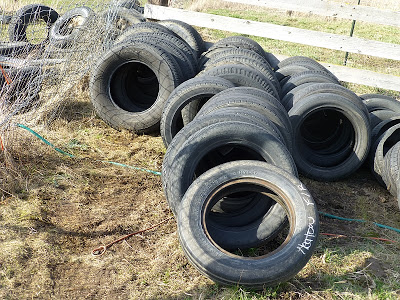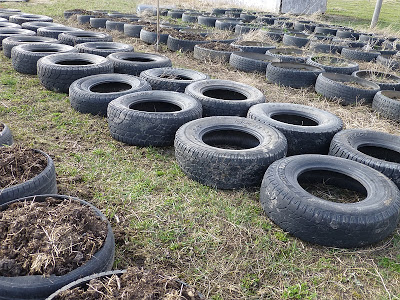

| Visitors Now: | |
| Total Visits: | |
| Total Stories: |

| Story Views | |
| Now: | |
| Last Hour: | |
| Last 24 Hours: | |
| Total: | |
Getting the garden ready
Well March lived up to its cliché in this part of Idaho: It came in like a lion and went out like a lamb. Personally I wasn’t so sure about the “lamb” part — during some parts of March we had a lot of wintry weather — but this past week or two has been very nice indeed.
Naturally the gardening bug is biting bad. It’s waaaay to early to put anything in the ground, but at least we can work on the infrastructure and get things ready.
Last year’s experiment in tire gardening was a smashing success, except for two things: weeds, and deer.
Our fences simply weren’t sufficient to keep out the deer, who are absolutely determined to be “one” with my garden. In a single night, they can undo what takes months to grow, grrr. I like deer, a lot, but not in my garden.
As for weeds — well, that’s why I decided to try tire gardening in the fist place. My garden is reclaimed from solid prairie, and after years of rototilling and trying to tame this mini-wilderness, I’ve only partially succeeded. What prairie grasses have been suppressed have only been replaced with weeds that come up so thick they literally obscure the garden (look at this link and you’ll understand).
So in preparation for this year’s expanded tire garden, we need to address both those issues.
First, deer. This can be done by raising the fences higher. Here Don is measuring one of the corner posts to determine how long to cut an extension, which he’ll bolt onto the post.
Here’s a pile of old 2x6s. We used these to cut into extensions.
Don cut them into three-foot lengths.
Here are some of the extensions. I think we ended up with about twenty.
We hauled out a ladder, thinking we’d need it, but it turned out we didn’t. See how short the fence is? Only six feet high. Silly us — a deer can jump that in his sleep.
To each garden pole that was too short, we bolted on extensions so we could raise the fence to eight feet.
Next issue: weeds. We’re not into using poison to control the weeds, so we debated endlessly on how to conduct large-scale weed control. The garden space is probably a quarter-acre, so this is a lot of space to control.
Let’s go back to last summer for a bit, when I was collecting tires as fast as I could. One of the things we did was collect five huge old tractor tires from a tractor dealer in a nearby town. These are massive things, hard to handle but with lots of potential as a garden bed once they’re in place.
The tires often come with a massive inner tube inside. Farmers fill these tubes with salt water (so they won’t freeze), and the result is this squishy, watery, thick rubber… thing.
We’re not quite sure what to do with them, but we figure this much high-quality rubber might come in useful some day, so we’ll hang onto them. Meanwhile, though, the inner tubes have just been sorta hanging around.
Then one day we noticed something interesting. If we moved an inner tube after it had been sitting for awhile, we saw that the ground beneath was totally devoid of plant life. Nothing could grow through that solid mass of rubber — it utterly cut the sunlight.
So it got us wondering — could we collect enough old tractor-tire inner tubes, split them open, and lay them between the rows in the garden to control weeds? The idea was interesting, but a split-open inner tube (we learned) is such an odd shape that nothing would piece neatly together.
But the idea lingered in our heads, the concept of literally covering the garden with something to cut weeds, while keeping the tires as little raised-bed islands of growth.
Then one day Don was surfing the internet, pricing tarps or whatever that we might use to lay down in the garden, when he came across something neither of us had considered before: old billboard tarps.
Billboards these days are merely great big empty signs. When a business wants to advertise, they don’t paint their advertisement directly on the sign. Instead, they have the advertisement printed on a massive sheet of vinyl, which is then plastered to the billboard. This vinyl is high-quality and durable — it has to be, since it’s out in all kinds of weather.
And what happens to these vinyl signs when the ad is finished? Don found many sources on eBay.com and other locations, selling old billboard vinyl.
So we decided to purchase some of these old billboards. A bit pricey, but it was the most cost-effective solution we could think of.
Then a couple months ago, we got to thinking — why do we need to purchase them off the internet? Why can’t we go to a local billboard manufacturer and purchase them from the source? A few phone calls had me connected with a company in Spokane. I explained my interest and asked how much they would be willing to sell their old billboard vinyl.
The price? Free. Free is good!
The company recycles its old billboard vinyl, and by policy they cannot sell these tarps. They can, however, give them away.
It was like discovering gold! Have you any idea how many uses a large waterproof tarp has on a farm? The possibilities are endless.
It has turned into a happy relationship. The company is thrilled someone can make use of the old billboards, and we’re thrilled to acquire — for free — an bottomless supply of high-quality tarps. We plan to collect as many tarps as they’ll let us have. Since they’re free, I explained to the very nice fellow, Sam (my contact) that I would never SELL any of the tarps they give me, but I will happily share them with friends and neighbors who need some weed control or hay tarps or anything like that.
Now whenever I go to Spokane, I make it a policy to stop at this company and load up on as many tarps as the car will hold. This is a stack of billboard tarps in the company’s courtyard.
Some tarps in the car.
Some tarps in the barn. This stack has gotten larger since the photo was taken.
Tarping the garden will offer two huge advantages: weed control, of course, but also it will mean surface runoff from rainwater will keep our pond full, since the pond is right next to the garden. We plan to lay the tarps color-side up, overlap them a bit shingle-style (heading down slope), then anchor with gravel. We estimate it will take two full truckfuls of gravel to “pave” the whole garden.
The tarps are thoughtfully marked with their size, so we’re stacking roughly according to dimension. What is advertised, however, is anyone’s guess until we open the tarp. (The girls are hoping to find a Hobbit movie advertisement, but unfortunately that’s not likely.)
Our road is still to soft and wet (meaning, there are weight restrictions) so we can’t order the gravel yet. This means we can’t start laying out too many tarps, because they’ll just blow around. However I wanted to get a brief start because I wanted to see how hard it would be to fit the tarps around the existing tires already placed in the garden.
So I trundled a tarp out to the garden…
…to a spot where I had planted some corn last year.
I unfolded the tarp. It turned out to be a McDonald’s ad.
Obviously I need to cut away the vinyl covering the tires.
Since the tractor tire sidewalls arc, I cut a circle of vinyl smaller than the full diameter of the tire, and pulled it off.
Then I made four slits at compass points, in order to allow the hole to fit over the tire. (By the way, a boxcutter slices the vinyl like butter. Scissors would also work.)
This is how the first tire came out.
Then the second tire.
I laid out a second billboard tarp, which turned out to be an advertisement for a dental office in Spokane. Laying out the tarp and cutting out the holes for the tires only took about ten minutes or so. And sheesh — look at the potential for wide-scale weed control, especially once the tarps are anchored with gravel!!
Emboldened by this success, Don cut me another tractor tire. We have three tractor tires that have been laying around all winter. He decided to cut the biggest. The turn thing is so huge — six feet in diameter and at least 300 lbs. — that we had to lever it off the ground with an iron pole before we could reach underneath and heave it upright. Possessing a strong back is an under-appreciated asset on a farm, I can tell you that.
Cutting these things is no joke and requires care. Not only do we have to be careful cutting, but we have to be careful the tire won’t flop over and land on one of us during the cutting process. Having a 300-lb. weight fall on top of us could cause serious injury.
Don got out his trusty Saws-All and began slicing. Instantly the smell of burning rubber filled the air. Turns out his blade was too fine and did little more than burn the rubber. (That black smear on the blade is melted rubber.)
So he replaced it with a new “fang-tip” blade. Oooh, sounds impressive, doesn’t it?
I balanced the tire while Don cut, but I was concerned because the closer he got to completing the cut through the entire diameter of the tire, the more the tire would sag and flop open, and I knew I wouldn’t be able to control a 150-lb. tire half in each hand. So we got some stout haybale twine and tied the tire as we went.
Peekaboo!
Tying the tire looked kinda funny, but it worked!
At this point Don went into the house to get a pair of gloves, and I went into the garden to determine where to put the tire halves. All of a sudden I heard a loud WHUMP. Oops. Fortunately it fell against the trailer, which meant we didn’t have to lift it from the ground up once again.
Before moving the tire (which I decided would be filled with strawberry plants) we spread a tarp next to one of the strawberry raised beds. This tarp advertised a casino.
Having the tire halves tied together meant we could very, very carefully roll both pieces at the same time to the right position in the garden. Took awhile but we managed. (And for those who wonder why we didn’t just cut the tire when it was already positioned in the garden, it’s because we didn’t have enough extension cords to reach.)
Once we had the tire where we wanted it to be, it was timberrrrr!
Then it was simply a matter of positioning the tire halves where we wanted them to go.
When I’m ready to plant, I’ll cut the vinyl out of the center, line it with cardboard (to discourage weeds), and fill it with composted manure.
Meanwhile I had a bunch of tires left over from last year which I had stacked neatly, waiting for spring. It was time to start processing.
Since there was already a “fangtip” blade (ooooh!) on the Saws-All, I started cutting out sidewalls. Cutting a sidewall takes less than thirty seconds.
While I worked, Younger Daughter asked if she could lay out a tarp and use some tires in order to plant flowers. Heck yeah! Plenty of room, plenty of tarps, plenty of tires. Help yourself. So she got busy on her own project.
Over the next two days, I cut the sidewalls out of 24 tires (I can’t endless tires all at once because the bend-over cutting position is hard on the back). This made significant inroads into my tire collection.
I rough-laid them in place but won’t fill them until we get some gravel delivered and I can tarp the ground.
There’s still a lot to do before the garden will be in plant-able condition. However at least this year we’ve got time. Last year we didn’t conceive of the tire garden concept until about mid-May, leaving very little time to get the infrastructure set up. This year the weather is cooperating to get a lot of preliminary work done in good time.
2013-04-03 06:51:58
Source: http://www.rural-revolution.com/2013/04/getting-garden-ready.html
Source:



